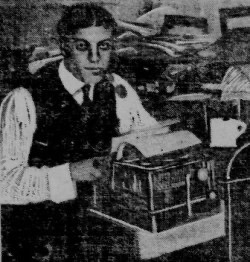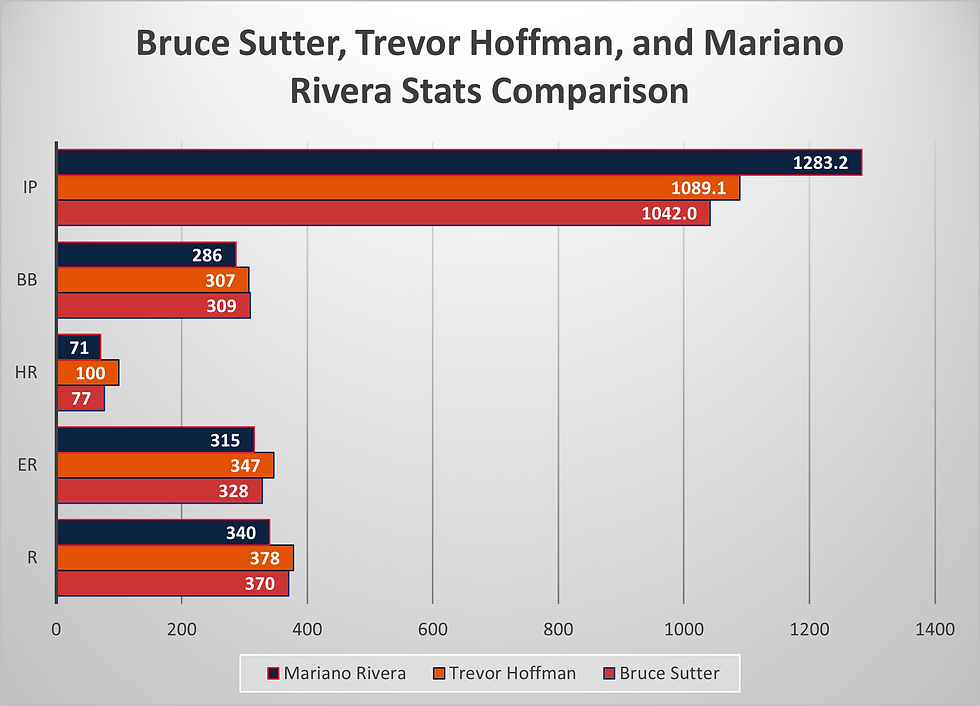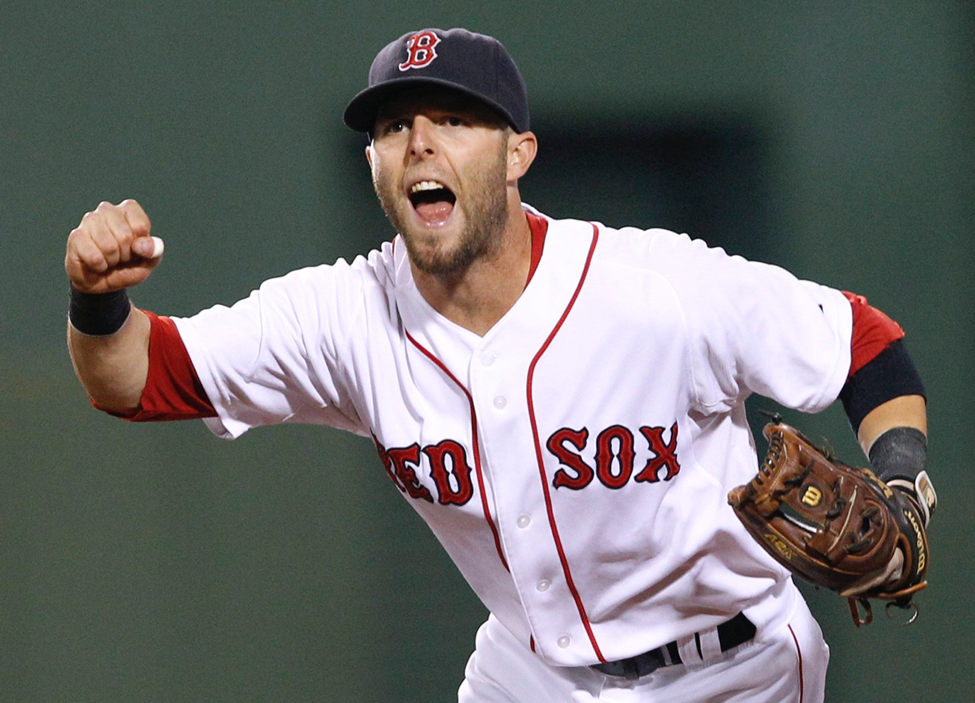Average Numbers for National Baseball Hall of Famers: Relief Pitchers
- John Butler

- Feb 15, 2022
- 7 min read

Mariano Rivera was unanimously enshrined into the Hall of Fame’s class of 2019, becoming the first member to be voted on 100% of ballots. Rivera got in alongside Roy Halladay, Edgar Martínez, and Mike Mussina. Photo by SB Nation Pinstripealley.
Jack Butler
Relief pitchers have changed how the game is played as before their relevance; managers relied on starters to go the distance. In the 1960s, Hoyt Wilhelm became a prominent reliever with the Chicago White Sox while the next decade made the position what it is today. The Oakland Athletics were a dynasty in the 1970s winning three World Series Championships from 1972-1974 and Rollie Fingers became the first star reliever. In the 1980s, Bruce Sutter and Rich Gossage combined to lead their respective league in saves 5 times, Lee Smith began his dominance with the Chicago Cubs and the A’s transformed Dennis Eckersley from starter to reliever and boy did it work. The next decade saw the beginning of two of the greatest relievers ever in Trevor Hoffman and Mariano Rivera who are the only relievers with 600 or more saves. Those are the 8 relief pitchers inducted into the Baseball Hall of Fame which is the second least number of players enshrined by position as designated hitters take that crown with three, comprising of Harold Baines, Edgar Martínez, and David Ortiz. Now, let’s take a deep dive into the average numbers for Hall of Fame relief pitchers.
Starting off with Wins Above Replacement (WAR), the average is 39.1 which was met by half of relievers, but Dennis Eckersley’s 62.1 WAR is misleading since he spent the first 12 years of his career as a starter. During his time as a starter, Eckersley had a 45.4 WAR compared to a 16.8 WAR as a reliever. The argument can be made that this metric doesn’t reflect a good relief pitch since they throw less innings and have fewer chances to impact a single game than starters do. For instance, Rollie Fingers, Bruce Sutter, Trevor Hoffman, and Lee Smith all have a WAR below 30, but each saved at least 300 games and have a career ERA below 3.04.

Looking at total WAR of the Hall of Fame relief pitchers, 4 of the 8 have a WAR over 40.0 which includes Rich Gossage, Hoyt Wilhelm, Mariano Rivera, and Dennis Eckersley. On the other end, Bruce Sutter’s 24.1 WAR is impressive from the standpoint of only playing for 11 years. Graph by Jack Butler.

Solely looking at WAR accumulated as a relief pitcher, the biggest drop off in WAR is Dennis Eckersley who was first in total WAR at 62.1. However, Eckersley only put up a 16.8 WAR as a reliever from 1987-1998. Graph Jack Butler.
Wins are inflated from Hoyt Wilhelm, Rollie Fingers, Dennis Eckersley, and Rich Gossage who each won 114 games or more. With those four removed, the win total would stand at 71 being met by Mariano Rivera and Lee Smith. Losses were inflated by the same four relievers with the average losses at 102. Another stat that is not important for relievers is win percentage as they can’t control the other parts of their team – defense and generating runs – so sometimes a reliever is in line for the win or save when an infielder mishandles a ball up the middle costing them the game. Those who are wondering, the average win percentage stands at .507.
The average ERA for a Hall of Fame reliver is 2.86 which is 17 points better than the starters. Surprisingly, ERA was only met by Hoyt Wilhelm, Bruce Sutter, and Mariano Rivera with the lowest ERA belonging to Rivera at an impressive 2.21. Games appeared in sits at 990 and is reached by 6 of the 8 Hall of Fame relievers with Rivera having the most appearances with 1,115 games and Sutter with the least at 661. Games finished and saves are two of the most important stats when evaluating relivers where the averages stand at 718 and 413 respectively. Only the last three relief pitchers inducted exceeded both games finished and saves and did it by a considerable margin. Between those three relivers the average for games finished would be 870 and saves at 577. In regard to saves, it seems that the voters overlook a reliever with high save numbers such as John Franco, Joe Nathan, and Billy Wagner since they weren’t as dominate. Using that logic, it makes sense that Bruce Sutter was inducted as he exceeded the minimum number of seasons played at 10 with 12 and reached the magic 300 save mark that voters coveted at the time. Sutter was nothing the league had seen before, but it shouldn’t have taken him 12 years to get into the Hall of Fame considering that the previous 3 relievers inducted had between 228 to 390 saves.
Fast forward to 2019 when Lee Smith was finally inducted via the Veterans Committee who stood atop the all-time saves list for more than a decade until Trevor Hoffman passed him in 2006 and finished with 601 saves. Mariano Rivera passed Hoffman in saves in 2011 ending up with 652 saves and both set new standards for relief pitchers that might not be met or exceeded anytime soon. Thus, the Hall of Fame needs to rethink its criteria when it comes to relievers as it’s very unlikely any player is touching 600 saves unless they averaged 30 saves a season over a 20-year career. So, give John Franco, Joe Nathan, and Billy Wagner all another look as the last player mentioned will by the Baseball Writers Association of America (BBWAA) for his 8th year on the writers’ ballot in 2023. Wagner is trying to reach 75% for induction in one of his last three chances and become the first left-handed reliever in the Hall.

Of the top 15 players on the all-time saves list, 5 are inducted into the National Baseball Hall of Fame, 2 are active players while the other 8 have not gotten into Cooperstown. These relivers average 419 saves which is met by 7 of them which consists of Billy Wagner, John Franco, Francisco Rodríguez, Lee Smith, Trevor Hoffman, and Mariano Rivera. Graph by Jack Butler.
Moving to innings pitched, Hoyt Wilhelm, Rollie Fingers, Dennis Eckersley, and Rich Gossage are outliers in the data set as each reliever tossed over 1700.0 innings with Eckersley pitching the most of the four with 3285.2. Eckersley only pitched 789.2 innings as a reliever racking up 387 saves, the other 3 came when he was a starter with the Cleveland Indians in the 1970s. Thus, the average is set for 1719.1 innings pitched that hasn’t been reached by the last three inductees.
Now looking at runs to base on balls, Mariano Rivera stands out over the rest by allowing less runs and earned runs than Bruce Sutter and Trevor Hoffman despite pitching more innings than them. Rivera allowed just 340 runs, 315 of them being earned, in 1283.2 frames compared to Hoffman and Sutter giving up 378 runs, 347 earned, in 1089.1 frames and 370 runs, 328 earned, in 1042.0 innings respectively. This is also the same with home runs and walks allowed where Rivera gave up 71 long balls and 286 walks while Hoffman allowed 100 home runs and 307 walks and Sutter yielded 77 dingers and 309 walks.

This graph compares runs, earned runs, home runs, and walks allowed along with innings pitched between Bruce Sutter, Trevor Hoffman, and Mariano Rivera. Rivera tossed roughly 200 more innings than Sutter and Hoffman and managed to issue a little over 20 less walks and allowed fewer home runs, earned runs, and runs than the other two Hall of Fame relievers. It goes to show how dominate Rivera was for 19 years and that there won’t be another reliever like him. Graph by Jack Butler.
Strikeouts is next and it is the fourth stat that Dennis Eckersley is an outlier. Eckersley had 1,627 strikeouts as a starter and 774 as a reliever which means he has the least number of strikeouts when solely looking at their reliever stats. His 2,401 total strikeouts are 791 more than Hoyt Wilhelm in second place and that's higher than Eckersley difference between total strikeouts and ones as a starter. Regarding the average for the 8 in Cooperstown, it stands at 1,404 with the last 3 inductees not reaching it and haven't been met since Rich Gossage was enshrined in 2008.
The final 3 stats to look at are ERA+, FIP, and WHIP and just like starters is essential when evaluating relief pitchers. Mariano Rivera is in his own class with his major league record 205 ERA+ while Hoyt Wilhelm and Trevor Hoffman are the other two reach the average of 140 with 147 and 141 respectively. Moving to FIP, the average is 3.06 and all the pitchers have an excellent rating by each having a FIP under 3.20 with the best belonging to Rivera at 2.76 and Rich Gossage has the highest at 3.18. The average WHIP of 1.141 for the relievers is better than the starters by 0.061. Only 4 of the 8 relievers reached the average with Rivera having an impressive 1.000 WHIP, Hoffman right behind with a 1.058 WHIP, Wilhelm in 3rd with a 1.125 WHIP and Sutter rounds out the 4 with a 1.245 WHIP.
Just with the starting pitchers, the BBWAA needs to set a new criterion when examining relief pitcher candidates on the Hall of Fame ballot as only 5 of the top 15 members on the all-time saves list are in Cooperstown. That's only 33%, but not arguing for all of them to be inducted as that'll decrease the value of the Hall and increase the relief pitchers from 8 to 18 for an 125% increase. Just look at the players numbers in the era that they played and don't set the bar for induction to be Mariano Rivera and Trevor Hoffman's stats since those probably won't be met again. The Hall needs to honor baseball's history to not only the guys who put up video game numbers, but to the ones who were overshadowed, put up worthy numbers, and were respected at their position.
Source
Baseball Reference. (2022). Retrieved February 14, 2022, from https://www.baseball-reference.com/







Comments